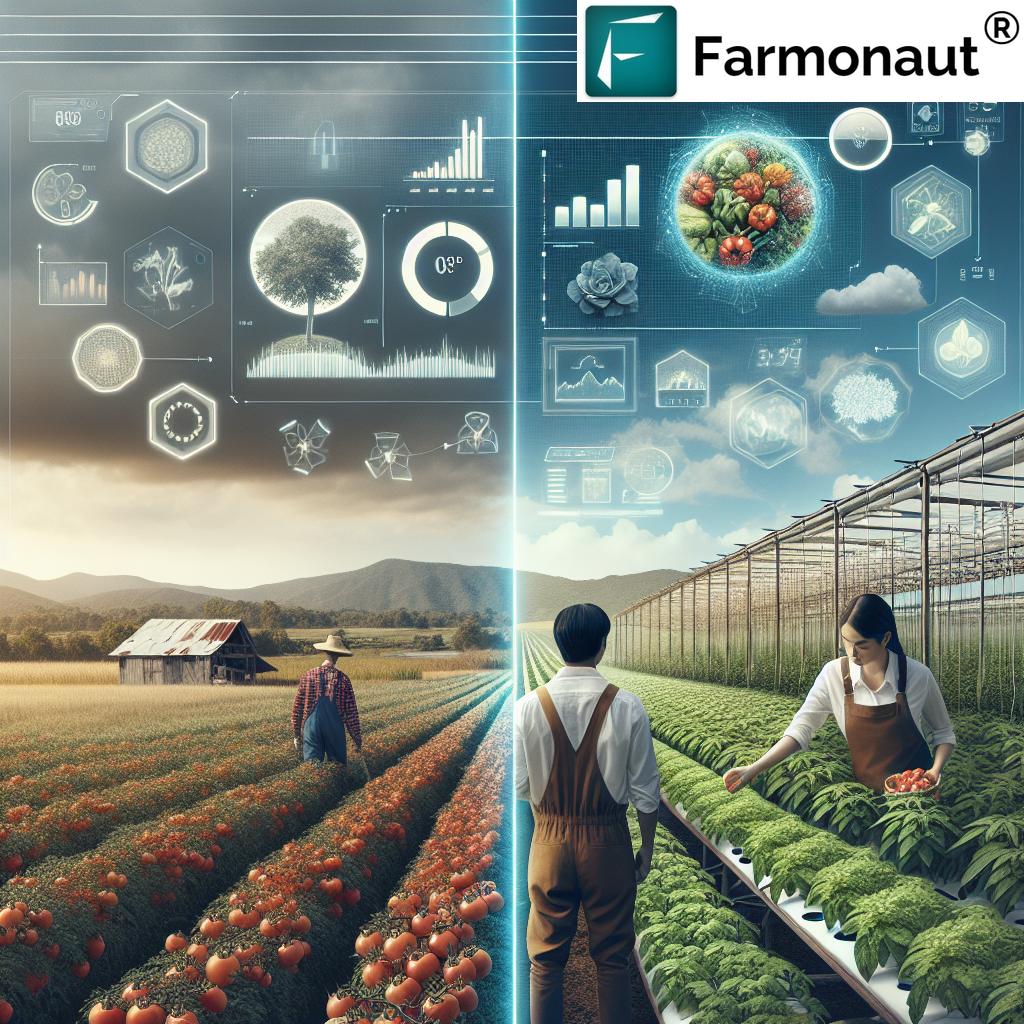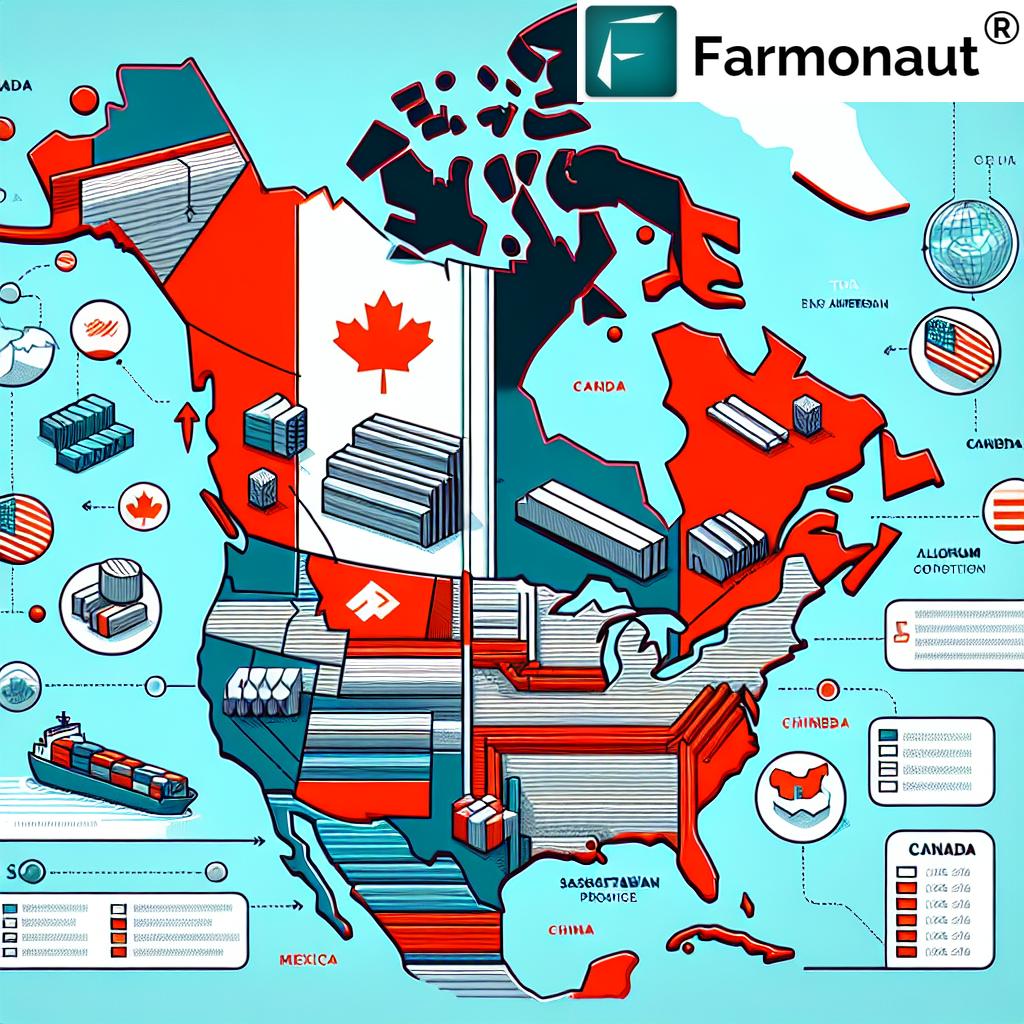USDA Amends Federal Order: Breakthrough for Canadian Greenhouse Tomato and Pepper Trade
“The revised Federal Order addressing ToBRFV impacts over 90% of North American greenhouse tomato and pepper production.”
In a significant development for the agricultural sector, the United States Department of Agriculture (USDA) has recently amended its Federal Order concerning the import of greenhouse tomatoes and peppers from Canada. This pivotal change marks a new chapter in North American agricultural trade, particularly in the realm of greenhouse vegetable production. As we delve into the implications of this amendment, we’ll explore how it affects tomato and pepper farming, biosecurity protocols, and the fresh produce supply chain across the continent.
Understanding the USDA’s Federal Order Amendment
The USDA’s decision to revise the Federal Order addressing the Tomato Brown Rugose Fruit Virus (ToBRFV) has sent ripples through the agricultural community. This amendment primarily eases restrictions on fresh produce imports, creating a more favorable environment for fruit and vegetable growers, especially those engaged in greenhouse vegetable production.
Let’s break down the key aspects of this amendment:
- Streamlined import processes for Canadian greenhouse tomatoes and peppers
- Updated biosecurity protocols that maintain robust plant health safeguards
- Revised focus on high-risk propagative materials
- Enhanced efficiency in the fresh produce supply chain
These changes reflect a nuanced approach to plant virus management and crop disease prevention, balancing the need for agricultural biosecurity with the demands of international trade.

Impact on Greenhouse Vegetable Production
The amendment to the Federal Order has significant implications for greenhouse vegetable production, particularly for tomato and pepper farming. Here’s how it’s set to transform the industry:
- Increased Trade Opportunities: Canadian growers now have easier access to the American market, potentially boosting cross-border vegetable trade.
- Enhanced Production Efficiency: With fewer bureaucratic hurdles, greenhouse operations can focus more on optimizing their production processes.
- Improved Supply Chain Dynamics: The streamlined regulations facilitate a more fluid movement of fresh produce across the Canada-US border.
- Adaptation of Farming Practices: Growers may need to adjust their cultivation methods to align with the updated biosecurity protocols.
These changes underscore the importance of staying informed about agricultural trade agreements and their impact on farming practices. For those in the industry, leveraging tools like Farmonaut’s satellite-based farm management solutions can provide valuable insights into optimizing greenhouse operations in light of these new regulations.
Balancing Biosecurity and Trade
One of the most critical aspects of the USDA’s amendment is its approach to balancing stringent agricultural biosecurity protocols with the need for efficient trade. The revised regulations focus on controlling high-risk propagative materials while easing restrictions on fresh produce. This nuanced approach aims to:
- Maintain robust plant health safeguards
- Facilitate smoother cross-border transactions
- Encourage sustainable greenhouse farming practices
- Support year-round availability of fresh produce
The emphasis on biosecurity highlights the ongoing need for effective crop disease prevention strategies. In this context, agritech solutions for crop protection, such as those offered by Farmonaut, play a crucial role. These technologies can help growers monitor crop health, detect potential issues early, and implement targeted interventions to maintain plant health within the framework of the new regulations.
The Role of Technology in Adapting to New Regulations
As the agricultural landscape evolves with these new regulations, technology plays an increasingly vital role in helping farmers adapt. Farmonaut’s suite of tools, including satellite-based crop monitoring and AI-driven advisory systems, can be particularly beneficial in this context. Here’s how:
- Real-time Crop Health Monitoring: Satellite imagery allows growers to keep a close eye on their crops, helping to identify potential issues before they escalate.
- Data-Driven Decision Making: Advanced analytics can help farmers optimize their greenhouse operations in line with new regulatory requirements.
- Efficient Resource Management: Precision agriculture tools can aid in maximizing yield while minimizing resource use, crucial for sustainable greenhouse farming.
- Traceability Solutions: Blockchain-based systems can enhance supply chain transparency, potentially easing compliance with import regulations.
By leveraging these technological solutions, greenhouse vegetable producers can not only comply with the new regulations but also enhance their overall operational efficiency.
Explore Farmonaut’s API for advanced agricultural data
Implications for Canadian and American Growers
The amendment to the Federal Order has far-reaching implications for both Canadian and American growers involved in greenhouse vegetable production. Let’s examine the potential impacts on both sides of the border:
For Canadian Growers:
- Expanded market access to the United States
- Potential for increased export volumes of tomatoes and peppers
- Need to adapt to new inspection and certification processes
- Opportunities to scale up greenhouse operations
For American Growers:
- Increased competition from Canadian imports
- Potential for collaborative ventures with Canadian counterparts
- Need to enhance efficiency to maintain market competitiveness
- Opportunities to learn from Canadian greenhouse farming practices
These changes underscore the importance of staying informed about agricultural trends and leveraging technology to maintain a competitive edge in the evolving market landscape.

“Streamlined regulations for ToBRFV control could potentially increase cross-border vegetable trade by up to 15% annually.”
The Future of North American Greenhouse Farming
As we look to the future of greenhouse vegetable production in North America, several key trends and considerations emerge:
- Technological Integration: The adoption of advanced technologies like those offered by Farmonaut will likely accelerate, helping farmers optimize their operations and comply with evolving regulations.
- Sustainable Practices: There will be an increased focus on sustainable greenhouse farming methods to meet growing consumer demand for environmentally friendly produce.
- Cross-Border Collaboration: We may see more partnerships between Canadian and American growers, leveraging each other’s strengths and expertise.
- Diversification of Crops: While tomatoes and peppers are currently in focus, the success of this regulatory change might pave the way for similar amendments for other greenhouse-grown vegetables.
- Enhanced Food Safety Measures: As trade increases, there will likely be continued emphasis on maintaining and improving food safety standards across borders.
These developments highlight the dynamic nature of the agricultural sector and the need for growers to remain adaptable and forward-thinking.
Check out Farmonaut’s API Developer Docs for integration possibilities
Comparing Previous and New Regulations
| Aspect | Previous Regulations | New Regulations |
|---|---|---|
| Import Restrictions | Stringent restrictions on Canadian tomato and pepper imports | Eased restrictions, facilitating smoother cross-border trade |
| Biosecurity Protocols | Broad-spectrum approach to plant health safeguards | Targeted focus on high-risk propagative materials |
| Focus on Propagative Materials | Less distinction between propagative and non-propagative materials | Enhanced controls specifically for high-risk propagative materials |
| Supply Chain Impact | More complex and time-consuming import processes | Streamlined procedures, potentially reducing processing time by up to 30% |
| Grower Benefits | Limited market access for Canadian growers | Expanded opportunities, with potential for 15% increase in cross-border trade |
The Role of Weather in Greenhouse Production
While greenhouse vegetable production offers more control over growing conditions compared to open-field farming, weather still plays a crucial role in overall operations and energy management. Understanding and predicting weather patterns can help greenhouse growers optimize their production strategies. Here’s how weather impacts greenhouse farming and how technology can help:
- Energy Management: Weather conditions directly affect heating and cooling needs in greenhouses. Accurate weather forecasting can help growers manage energy consumption more efficiently.
- Light Levels: While greenhouses provide controlled environments, natural light levels still impact plant growth. Monitoring and predicting light conditions can help in planning supplemental lighting strategies.
- Ventilation: Outdoor temperature and humidity levels influence greenhouse ventilation requirements. Real-time weather data can inform automated ventilation systems for optimal growing conditions.
- Pest and Disease Pressure: Certain weather conditions can increase the risk of pest infestations or disease outbreaks. Predictive weather models can help growers implement preemptive measures.
Farmonaut’s weather monitoring and forecasting capabilities can be particularly valuable for greenhouse operators looking to optimize their production in line with these weather-related factors.
The Impact on Food Safety and Quality
The USDA’s amendment to the Federal Order not only impacts trade and production but also has significant implications for food safety and quality. As the flow of fresh produce across borders increases, maintaining high standards of food safety becomes paramount. Here’s how the new regulations address these concerns:
- Enhanced Traceability: The revised regulations may encourage the adoption of advanced traceability systems, allowing for quicker identification and isolation of potential food safety issues.
- Focused Inspections: By concentrating on high-risk propagative materials, inspections can be more targeted and effective in preventing the spread of plant diseases.
- Collaborative Approach: The changes foster greater collaboration between US and Canadian food safety authorities, potentially leading to more harmonized safety standards.
- Technology-Driven Monitoring: The use of advanced technologies for crop monitoring and disease detection can contribute to maintaining high food safety standards.
These measures aim to ensure that the increased trade in greenhouse vegetables does not come at the cost of compromised food safety. Growers and distributors must remain vigilant and proactive in implementing robust safety protocols.
Economic Implications for North American Agriculture
The amendment to the Federal Order is expected to have significant economic implications for the North American agricultural sector, particularly in the realm of greenhouse vegetable production. Let’s explore some of the potential economic impacts:
- Increased Trade Volume: The easing of restrictions is likely to boost the volume of tomato and pepper trade between Canada and the US, potentially leading to economic growth in both countries’ agricultural sectors.
- Market Dynamics: The influx of Canadian produce may lead to increased competition in the US market, potentially affecting prices and market shares of domestic producers.
- Investment Opportunities: The new regulations may spur investments in greenhouse technology and infrastructure on both sides of the border as growers seek to capitalize on the expanded market opportunities.
- Job Creation: Increased production and trade could lead to job creation in various aspects of the agricultural supply chain, from farming to distribution and retail.
- Innovation Stimulus: The competitive landscape may drive innovation in farming practices, packaging, and transportation methods to meet the demands of cross-border trade efficiently.
These economic shifts underscore the importance of adaptability in the agricultural sector. Farmers and agribusinesses that can quickly adjust to the new market realities stand to benefit the most from these changes.
The Role of Technology in Adapting to New Regulations
As the agricultural landscape evolves with these new regulations, technology plays an increasingly vital role in helping farmers adapt. Advanced agritech solutions, such as those offered by Farmonaut, can be particularly beneficial in this context. Here’s how technology can assist growers in navigating the new regulatory environment:
- Satellite-Based Crop Monitoring: Real-time monitoring of crop health can help growers quickly identify and address potential issues, ensuring compliance with phytosanitary requirements.
- AI-Powered Advisory Systems: Advanced algorithms can provide personalized recommendations for crop management, helping farmers optimize their production in line with new trade opportunities.
- Blockchain-Based Traceability: Enhanced traceability solutions can streamline compliance with import regulations and boost consumer confidence in cross-border produce.
- Weather Forecasting and Analysis: Accurate weather predictions can aid in planning harvests and shipments, crucial for maintaining produce quality during international transport.
- Data Analytics for Market Insights: Big data analytics can help growers understand market trends and adjust their production strategies accordingly.
By leveraging these technological solutions, greenhouse vegetable producers can not only comply with the new regulations but also enhance their overall operational efficiency and competitiveness in the expanded market.
Environmental Considerations
While the amended Federal Order primarily addresses trade and biosecurity, it’s crucial to consider the environmental implications of these changes. The shift in greenhouse vegetable production and trade patterns could have various environmental impacts:
- Carbon Footprint: Increased cross-border trade may lead to more transportation-related emissions. However, efficient logistics and the use of greenhouse farming methods could potentially offset some of these impacts.
- Resource Efficiency: Greenhouse farming generally allows for more efficient use of water and land compared to traditional open-field farming. The expansion of this sector could lead to overall resource conservation.
- Pesticide Use: With a focus on high-risk propagative materials, there might be changes in pest management strategies, potentially leading to more targeted and reduced pesticide use.
- Energy Consumption: The potential growth in greenhouse operations could increase energy demand. This underscores the importance of adopting energy-efficient technologies and renewable energy sources in greenhouse farming.
- Biodiversity: While greenhouse farming has a smaller land footprint, expansion of these operations should be balanced with efforts to preserve local ecosystems and biodiversity.
Monitoring and managing these environmental factors will be crucial for ensuring that the growth in greenhouse vegetable production remains sustainable in the long term. Technologies like those offered by Farmonaut can play a significant role in helping farmers optimize their resource use and minimize environmental impact.
Challenges and Opportunities for Stakeholders
The amendment to the USDA Federal Order presents both challenges and opportunities for various stakeholders in the agricultural sector. Let’s examine how different groups might be affected:
Growers:
- Opportunities: Expanded market access, potential for increased production and sales.
- Challenges: Adapting to new regulations, potential increased competition.
Distributors and Retailers:
- Opportunities: Greater variety of produce, potentially lower costs due to increased supply.
- Challenges: Managing more complex supply chains, ensuring food safety across borders.
Consumers:
- Opportunities: Access to a wider variety of fresh produce year-round, potentially at more competitive prices.
- Challenges: Ensuring confidence in the safety and quality of imported produce.
Regulatory Bodies:
- Opportunities: Streamlined processes, focus on high-risk areas.
- Challenges: Maintaining effective oversight with increased trade volume.
Technology Providers:
- Opportunities: Increased demand for advanced farming and supply chain management solutions.
- Challenges: Ensuring solutions meet the evolving needs of the industry.
Navigating these challenges and opportunities will require adaptability, innovation, and collaboration across the industry. Stakeholders who can effectively leverage technology and data-driven insights will be better positioned to thrive in this evolving landscape.
Farmonaut Subscriptions
FAQs
Q: How does the USDA’s amended Federal Order affect Canadian greenhouse tomato and pepper exports?
A: The amendment eases restrictions on Canadian greenhouse tomato and pepper imports to the US, potentially increasing trade volume and streamlining the export process for Canadian growers.
Q: What are the main changes in biosecurity protocols under the new regulations?
A: The new regulations focus more specifically on high-risk propagative materials while easing restrictions on fresh produce, maintaining robust plant health safeguards while facilitating trade.
Q: How might this amendment impact US domestic greenhouse vegetable producers?
A: US producers may face increased competition from Canadian imports but could also benefit from potential collaborative opportunities and the need to enhance efficiency in their operations.
Q: What role does technology play in adapting to these new regulations?
A: Technology, such as Farmonaut’s satellite-based farm management solutions, can help growers optimize production, monitor crop health, and ensure compliance with new regulations more effectively.
Q: How does this amendment address food safety concerns?
A: The amendment maintains a focus on biosecurity while streamlining processes. It encourages the adoption of advanced traceability systems and fosters collaboration between US and Canadian food safety authorities.
Conclusion
The USDA’s amendment to the Federal Order marks a significant milestone in North American agricultural trade, particularly for greenhouse tomato and pepper farming. This change not only streamlines the supply chain but also opens up new opportunities for growers on both sides of the border. As the industry adapts to these changes, the role of technology in ensuring efficient, sustainable, and compliant farming practices becomes increasingly crucial.
Farmonaut’s suite of advanced agritech solutions stands ready to support growers in navigating this new landscape. From satellite-based crop monitoring to AI-driven advisory systems, our tools can help farmers optimize their operations, ensure compliance with new regulations, and thrive in the evolving market.
As we move forward, it’s clear that the success of North American greenhouse vegetable production will depend on the industry’s ability to balance biosecurity, efficiency, and sustainability. By embracing innovative technologies and collaborative approaches, stakeholders across the agricultural sector can turn these regulatory changes into opportunities for growth and improvement.
Stay informed, stay adaptable, and leverage the power of technology to make the most of this new chapter in North American agriculture.
















